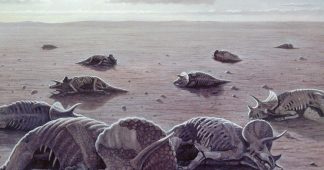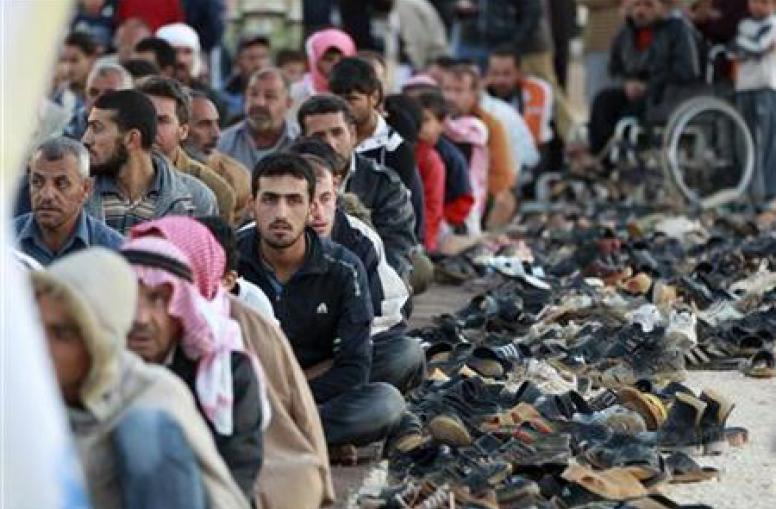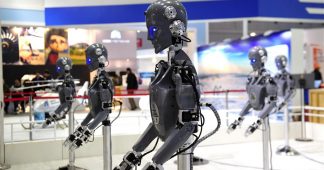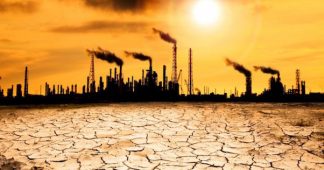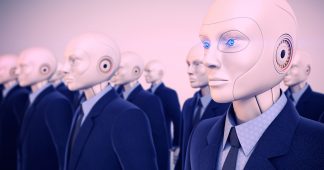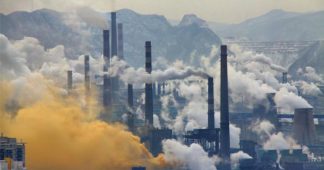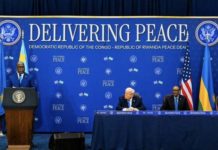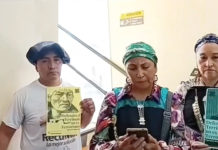Cribb, Julian
September 20, 2016
Humans are facing the greatest test in the million-year ascent of our kind. But this isn’t a single challenge, like a famine or disease outbreak. It is a constellation of ten huge man-made threats, which are now coming together to imperil our existence.
Society often regards these risks – ecological collapse, resource depletion, weapons of mass destruction, global warming, global poisoning, food insecurity, population and urban expansion, pandemic disease, dangerous new technologies and self-delusion – as separate issues. In reality, they are deeply intertwined: each affects the others. This means they cannot be dealt with one at a time, but must be solved in conjunction – and at species level.
Over recent years I have encountered many well-educated, well-informed people – scientists, grandparents and young people especially – who expressed the fear that we may be entering the end game of human history. That civilisation, and maybe even our species, will not survive the compound dangers we are accruing for ourselves. Surviving the 21st Century (Springer 2017) is my attempt to discover whether they are right or not.
Drawing on the latest and best science the book appraises each of those dangers – and also looks at what we need to do, both as a species and as concerned individuals – to avoid them. Finding ways to limit mortal danger is what humans generally do best – at least, that’s how we made it through the last million years. Almost certainly we have the technical ability to do so again. However, on the present evidence, our national governments, financial and other institutions lack the capacity, wisdom and will to solve this compound threat. In many cases, as Sir David Attenborough suggests, they are “in denial” about its sheer scale. Something has to change.
The end of civilisation and human extinction are distasteful topics. Nobody likes discussing them and many people prefer to ignore them as they go about their daily lives. But ignoring them does not banish the risk – inevitably, it only renders humanity less prepared, our future more perilous. There is no other way to deal with such a complex problem than to face up to it, to understand it thoroughly, and to then take resolute and agreed species-wide action to prevent it.
To take some examples:
Eco-collapse:
Dozens of species are thought to go extinct every day due to human activity. As the world’s greatest biologist, E. O. Wilson, warns “We are tearing down the biosphere” – the very thing that supports life on this Planet. Or as young environmentalist Bindi Irwin succinctly puts it “If you keep on pulling one brick after another out of your house, eventually the house falls down.”
The solution is not as hard as many imagine. It is to move half the world’s food production into cities and recycle both nutrients and water, and then ‘re-wild’ 24 million sq kms (an area the size of North America) under the wise management of indigenous people and farmers. It is to gradually replace mining with mineral recycling, and cease releasing toxins. Yet answers like these are not yet front-and-centre in our social and political discourse.
Resource scarcity:
In their lifetime, the average person uses 100,000 tonnes of fresh water, 750 tonnes of soil, 720 tonnes of metals, 5 billion energy units and emits 300 tonnes of greenhouse gas. No wonder resources are becoming scarce and landscapes worldwide being ruined to obtain them. The self-evident answer is to re-use everything, and then re-use it again. Thanks to technology the ‘circular economy’ is already feasible and becoming cost effective, while green energy is rapidly replacing fossil fuels. However resistance – by political and vested interests – continues to block it.
WMD:
The latest climate models indicate it would only require 50-100 Hiroshima-sized (i.e. small) nuclear bombs to eliminate civilisation in a nuclear winter. World stockpiles currently hold around 15,000 such devices, and the risk of their falling into terrorist hands is growing as nuclear materials are stolen, on average, every ten days (IAEA). A new technology-based arms race is under way among the major powers featuring things like pilotless nuclear drones and artificial intelligence (what could possibly go wrong?)
Nuclear conflict remains the most likely route by which civilization may be terminated, but the conflict itself will spiral out of other issues such as famines, quarrels over resources, population displacement, and collective delusions (e.g. political, religious, monetary or nationalistic). As the International Red Cross (and many others) have pointed out, the only way to banish the spectre of such a conflict is to ban and demolish all nuclear, chemical and biological weapons and their material stockpiles. Regrettably, nuclear governments and industry are loath to do this.
Climate’s hidden risk:
The release of 2.9 trillion tonnes of carbon dioxide into the atmosphere and oceans is predicted to drive the planet into a hot phase of +5-10 degrees Celsius above present temperatures. Humans have already released 1.9 trillion tonnes of carbon dioxide and are adding 50 billion tonnes a year by burning fossil fuels and clearing land. The big risk is that, as the planet warms, this will cause the release of all or a part of the 50 billion tonnes of methane locked in the tundra and seabed, causing unstoppable ‘runaway’ warming. Scientists fear this may render the Earth uninhabitable to large life forms, including humans. [Edited September 29th]
As most people now know, the only way to prevent this is to cease using all of fossil fuels and revegetate half the world’s land mass. This can be accelerated by a switch to urban agriculture, carbon farming and landscape restoration – the same solution as for ecological collapse. Green energy is advancing by leaps and bounds and will soon be in a position to take over from fossils. Governments, however, paid off by the 90 big companies who make up the bulk of the fossil fuel industry, are hampering this transition.
The poisoned planet:
Every day, every child on our planet is poisoned by man-made toxins. The whole of humanity and indeed, all life on Earth, is mired in a toxic swamp of 250 billion tonnes of annual chemical emissions from human activity. They are in our food, our water, the air we breathe, the furnishings and materials of our homes, vehicles, schools and workplaces, in wildlife, the oceans, in our bodies and even, now, in our genes. Humanity’s chemical emissions are four times greater even than our carbon dioxide emissions. Medical evidence that this combined assault is damaging human intelligence, gender, reproduction and health is mounting. With IQs being damaged in all industrial societies there is a risk we may become too unintelligent as a species to save ourselves.
There is an answer, though not an easy one. It is for consumers worldwide to stop buying toxic goods and foods, and to start rewarding companies which produce clean, safe products. This requires an act of co-operation and knowledge sharing on a global scale, to cleanse our poisoned planet. Concerned citizens, parents, cancer societies, doctors, environmentalists and others are already uniting, worldwide, to start this process. There must be a new human right: not to be poisoned.
Food security:
World food security is on a knife-edge – for the simple reason that population and economic growth between them will drive a doubling in global food demand by the 2060s – while the world is running out of everything needed to satisfy it by traditional methods: topsoil, freshwater, wild fish, oil and fertiliser. Also we have already extinguished the climate in which agriculture was born. Governments and ‘Big Food’ don’t get this.
Food perfectly illustrates the dilemma humanity faces: to solve the problem using modern high intensity agriculture will only (a) worsen climate change, (b) destroy more land and water, (c) accelerate extinctions, (d) displace a billion small farmers, and (e) undermine human health. In other words, it’s a solution that makes things far worse.
On the other hand, producing half the world’s food in cities using recycled water and nutrients, by converting the rest to low-intensity carbon eco-agriculture, and rewilding the abandoned lands is a win-win-win which addresses several of the mega threats.
These examples illustrate the compound challenges humanity faces during the 21st Century, and the necessity for cross-cutting solutions. The evidence for them is overwhelming and cannot be denied by rational people – only ignored. But, as the book illustrates, all these issues are potentially soluble with wisdom, co-operation and technology.
However the greatest challenge may lie, not in the physical threats we face, but in our own minds. Our belief in non-material things like money, politics, religion and the human narrative often diverts and weakens our efforts to work together for survival. This has to change. Pope Francis, in his encyclical Laudato Si, demonstrated how religion can be re-dedicated to human survival – and it is essential that money, politics and the human narrative are similarly reinvented. Otherwise they will sabotage the very actions essential to our continuance.
There are also two extremely promising developments. The advent of a new human ability to ‘think as a species’ by sharing knowledge and values through the internet and social media is reshaping, for all time and for the better, our ability to co-operate around the planet. And the emergence of women as leaders in all walks of society is changing how humanity thinks about the future: women, as a rule, do not start wars, dig coal, ravage landscapes, empty the oceans, wipe out other species and knowingly poison their offspring. They think about the children and the grand children, and their needs – and they have already made a start on the population threat by reducing the human birth rate worldwide.
Such ways of thinking are a universal necessity for Homo sapiens, if civilisation and our species are to survive the 21st Century.
Julian Cribb is an Australian science writer and author of Surviving the 21st Century (Springer 2017), the conclusion of his trilogy about how humanity can overcome the existential threats it has created. Surviving the 21st Century can be found here.
September 29th, the above article was edited to clarify measurements of carbon, carbon dioxide, and methane.
